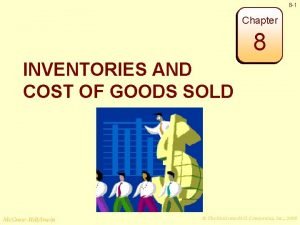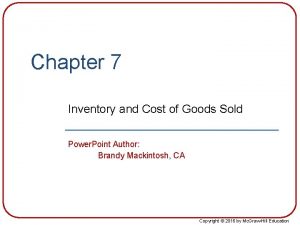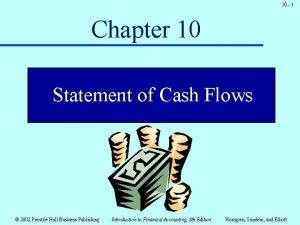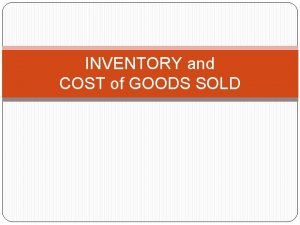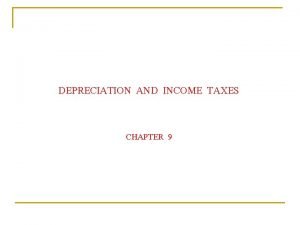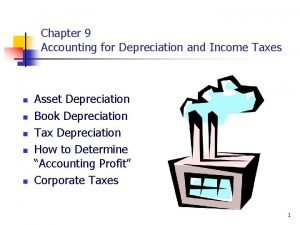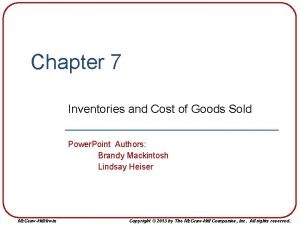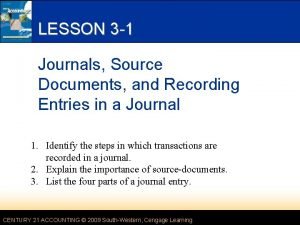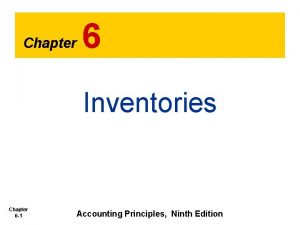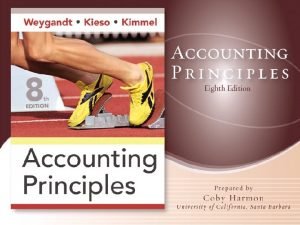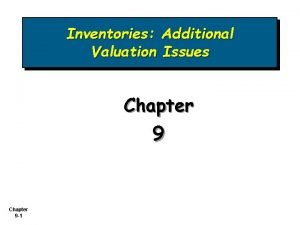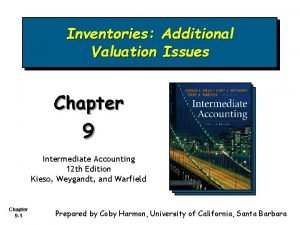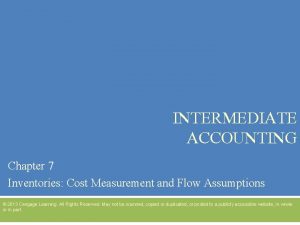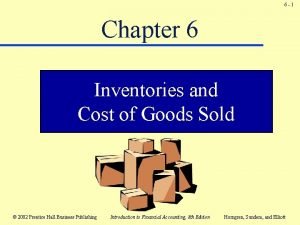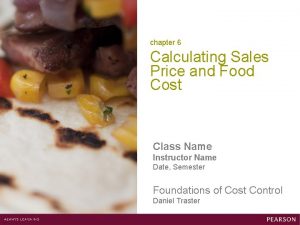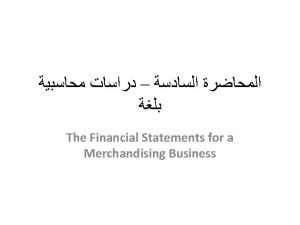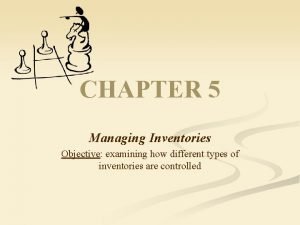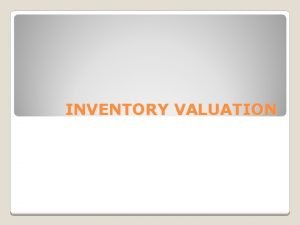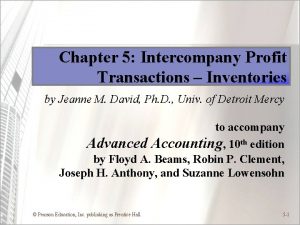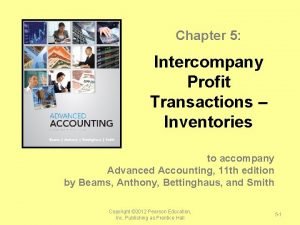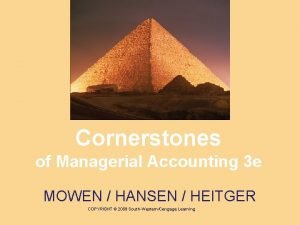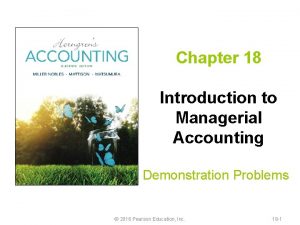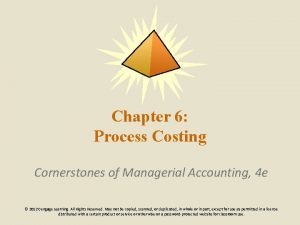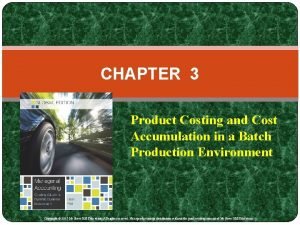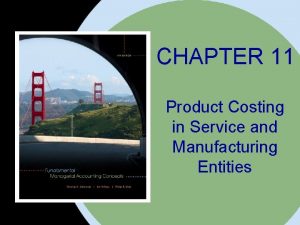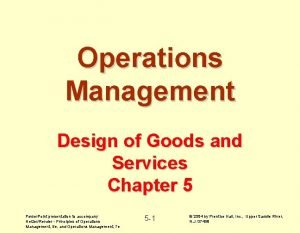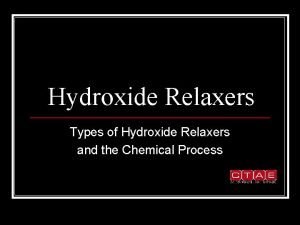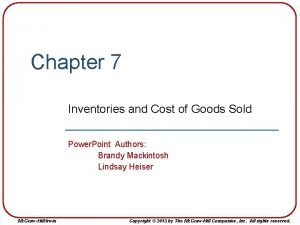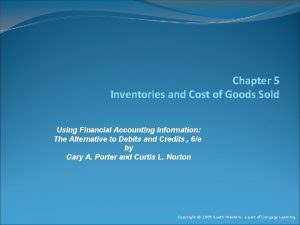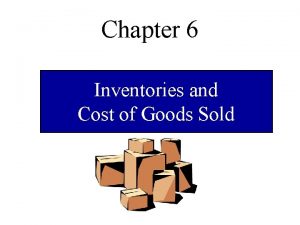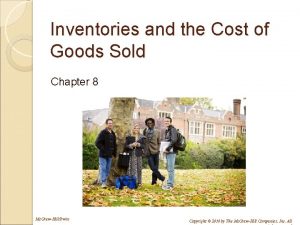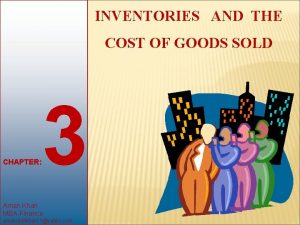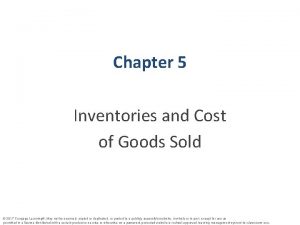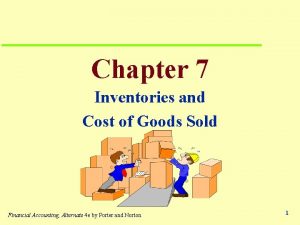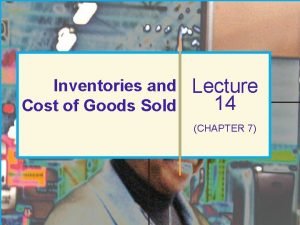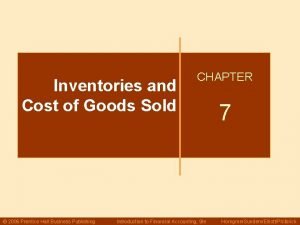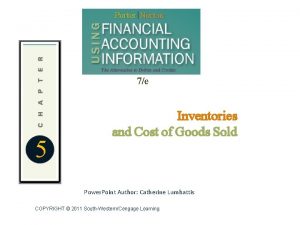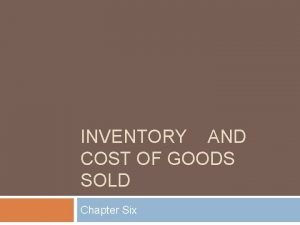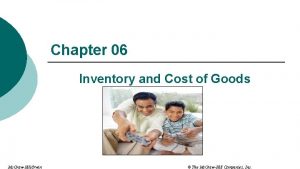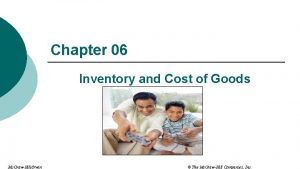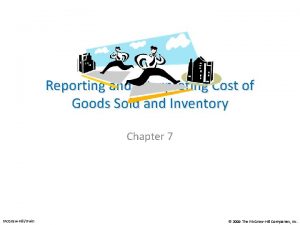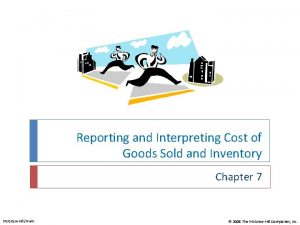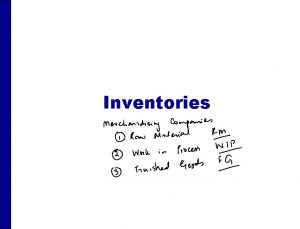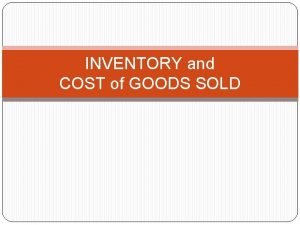Chapter 6 Inventories and Cost of Goods Sold


![CIRCUIT CITY Consolidated Balance Sheets [Partial] ASSETS (in thousands) February 28, 2002 2001 CURRENT CIRCUIT CITY Consolidated Balance Sheets [Partial] ASSETS (in thousands) February 28, 2002 2001 CURRENT](https://slidetodoc.com/presentation_image_h/77455bc93031189d3f6f318c0a77422b/image-3.jpg)


![NIKE, INC. Consolidated Balance Sheets [Partial] ASSETS (in millions) May 31, 2001 2000 Current NIKE, INC. Consolidated Balance Sheets [Partial] ASSETS (in millions) May 31, 2001 2000 Current](https://slidetodoc.com/presentation_image_h/77455bc93031189d3f6f318c0a77422b/image-6.jpg)



















































- Slides: 57

Chapter 6 Inventories and Cost of Goods Sold Financial Accounting 4 e by Porter and Norton 1

Inventory of Wholesalers and Retailers u Purchased in finished form u Resold without transformation u Classified as “Merchandise Inventory” on balance sheet 2
![CIRCUIT CITY Consolidated Balance Sheets Partial ASSETS in thousands February 28 2002 2001 CURRENT CIRCUIT CITY Consolidated Balance Sheets [Partial] ASSETS (in thousands) February 28, 2002 2001 CURRENT](https://slidetodoc.com/presentation_image_h/77455bc93031189d3f6f318c0a77422b/image-3.jpg)
CIRCUIT CITY Consolidated Balance Sheets [Partial] ASSETS (in thousands) February 28, 2002 2001 CURRENT ASSETS: Cash and cash equivalents More $1, 251, 532 Net accounts and notes receivable than 585, 761 1/3 Merchandise inventory 1, 633, 327 of total Prepaid expenses and other current assets 57, 623 TOTAL CURRENT ASSETS 3, 652, 711 $ 446, 131 726, 541 1, 757, 664 41, 311 2, 847, 179 Property, plant and equipment, net 853, 778 Other assets 32, 897 35, 207 TOTAL ASSETS $4, 539, 386 988, 947 $3, 871, 333 3

Inventory of Manufacturers Costs Included in Inventory Direct Materials Direct Labor Manufacturing Overhead 4

Inventory of Manufacturers Balance Sheet Classifications Costs Included in Inventory Direct Materials Direct Labor Manufacturing Overhead Raw Materials Manufacture Products Work in Process Finished Goods 5
![NIKE INC Consolidated Balance Sheets Partial ASSETS in millions May 31 2001 2000 Current NIKE, INC. Consolidated Balance Sheets [Partial] ASSETS (in millions) May 31, 2001 2000 Current](https://slidetodoc.com/presentation_image_h/77455bc93031189d3f6f318c0a77422b/image-6.jpg)
NIKE, INC. Consolidated Balance Sheets [Partial] ASSETS (in millions) May 31, 2001 2000 Current assets: Cash and cash equivalents $ 304. 0 $ 254. 3 Accounts receivable less allowance for doubtful accounts of $72. 1 and $65. 4 1, 621. 4 1, 569. 4 Inventories: Finished goods 1, 399. 4 1, 416. 6 Work in progress 15. 1 17. 3 Raw materials 9. 6 12. 1 1, 424. 1 1, 446. 0 Deferred income taxes 113. 3 111. 5 Prepaid expenses 162. 5 215. 2 Total current assets 3, 625. 3 3, 596. 4 Property, plant and equipment, net 1, 618. 8 1, 583. 4 Identifiable intangible assets and goodwill 410. 9 397. 3 6

Inventory Valuation and Income Measurement Value Assigned to Inventory on Balance Sheet When Sold = Value Expensed as Cost of Goods Sold on Income Statement 7

Calculating Cost of Goods Sold t Internal calculation Beginning inventory + Purchases = Cost of goods available for sale - Ending inventory = Cost of goods sold $ 500 1, 200 1, 700 (600) $ 1, 100 8

Inventory costs include u Any freight costs incurred by buyer u Cost of insurance for inventory in transit u Cost of storing inventory before selling u Excise and sales taxes 9

Inventory Costing Methods Four costing methods available: Specific Identification Weighted Average First-in, First-out (FIFO) Last-in, First-out (LIFO) 10

Detailed Costing Method Example Calculate the cost of goods sold and ending inventory under each method using the data below: Beginning inventory, Jan. 1: 500 units (unit cost $10) Inventory purchases: Date Units 1/20 300 4/8 400 9/5 200 12/12 100 Total purchases 1, 000 Ending inventory, Dec. 31: 600 units Unit Cost $ 11 12 13 14 11

Specific Identification Method Step 1: Identify the specific units in inventory at the end of the year and their costs. 12

Specific Identification Method Units in ending inventory: Date purchased Units Cost Total cost 1/20 100 $11 $1, 100 4/8 300 12 3, 600 9/5 200 13 2, 600 Ending inventory 600 $7, 300 Units x Cost = Total cost 13

Specific Identification Method Step 2: Identify the units sold and calculate the cost of goods sold. 14

Specific Identification Method Date purchased Units Cost Total cost Beg. Inventory 500 $10 $5, 000 1/20 200 11 2, 200 4/8 100 12 1, 200 12/12 100 14 1, 400 Cost of goods sold 900 $9, 800 Units x Cost = Total cost 15

Weighted Average Method Step 1: Calculate the cost of goods available for sale. 16

Weighted Average Method Date purchased Units Cost Total cost Beg. inventory 500 $10 $ 5, 000 1/20 300 11 3, 300 4/8 400 12 4, 800 9/5 200 13 2, 600 12/12 Cost of goods available for sale 100 14 1, 400 1, 500 $17, 100 17

Weighted Average Method Step 2: Divide the cost of goods available for sale by the total units to determine the weighted average cost per unit. : 18

Weighted Average Method Cost of Goods Available Units Available $17, 100 = $ 11. 40/unit 1, 500 19

Weighted Average Method Step 3: Calculate ending inventory and COGS by multiplying the weighted average cost per unit by the # of units in ending inventory and the # of units sold. Avg. Cost X # Units 20

Weighted Average Method Units on hand Units sold Weighted average cost X Total cost of goods available of $17, 100 allocated: ALLOCATE TO Ending Cost of Inventory Goods Sold 600 900 $11. 40 $6, 840 $10, 260 21

First-in, First-out (FIFO) Method Step 1: Assign the cost of the beginning inventory to cost of goods sold. 1 st in 22

First-in, First-out (FIFO) Method Units Cost 1/1 500 $10 1/20 300 $11 4/8 400 $12 9/5 200 $13 12/12 100 $14 ALLOCATE TO Ending Cost of Inventory Goods Sold $5, 000 23

First-in, First-out (FIFO) Method Step 2: Continue to work forward until you assign the total # of units sold during the period to cost of goods sold. Allocate the remaining units to ending inventory. 2 nd 3 rd etc. 24

First-in, First-out (FIFO) Method ALLOCATE TO Ending Cost of Inventory Goods Sold Units Cost 1/1 500 $10 $5, 000 1/20 300 $11 3, 300 4/8 300 / 100 $12 $3, 600 9/5 200 $13 2, 600 12/12 100 $14 1, 400 TOTALS $7, 600 1, 200 $9, 500 25

Last-in, First-out (LIFO) Method Step 1: Assign the cost of the last units purchased to cost of goods sold. 1 st in 26

Last-in, First-out (LIFO) Method Units Cost 1/1 500 $10 1/20 300 $11 4/8 400 $12 9/5 200 $13 12/12 100 $14 ALLOCATE TO Ending Cost of Inventory Goods Sold $1, 400 27

Last-in, First-out (LIFO) Method Step 2: Work backward until you assign the total # of units sold during the period to cost of goods sold (allocate the remaining units to ending inventory). 1 st in 28

Last-in, First-out (LIFO) Method Units Cost ALLOCATE TO Ending Cost of Inventory Goods Sold 1/1 500 $10 $5, 000 1/20 100 / 200 $11 1, 100 4/8 400 $12 4, 800 9/5 200 $13 2, 600 12/12 100 $14 1, 400 TOTALS $6, 100 $2, 200 $11, 000 29

Comparison of Costing Methods Ending Inventory Specific Identification Cost of Goods Sold Goods Available for Sale $7, 300 9, 800 $17, 100 Weighted Average 6, 840 10, 260 17, 100 FIFO 7, 600 9, 500 17, 000 LIFO 6, 100 11, 000 17, 100 30

Comparison of Costing Methods In periods of rising prices: Weighted Avg. FIFO LIFO highest COGS? lowest COGS? highest gross margin? lowest net income? lowest income taxes? X X X 31

LIFO Issues · LIFO Liquidation · liquidation can result in high gross margin (and large tax bill) · LIFO Conformity Rule · if used for tax, LIFO must also be used for books · LIFO Reserve · difference between inventory value stated at FIFO and value stated at LIFO 32

Reasons for Inventory Errors u Mathematical mistakes u Physical inventory counting errors u Cut-off problems - in-transit u Goods on consignment 33

Effect of Inventory Errors on the Income Statement Sales Beginning inventory Add: Purchases Goods available for sale Less: Ending inventory Cost of goods sold Gross margin Operating expenses Net income Reported $1, 000 $ 200, 000 700, 000 $ 900, 000 300, 000 $ 600, 000 $ 400, 000 150, 000 250, 000 Corrected Effect $1, 000 200, 000 700, 000 $ 900, 000 250, 000 $50 OS $ 650, 000 50 US $ 350, 000 50 OS 150, 000 200, 000 50 OS OS = overstatement US = understatement 34

Effect of Inventory Errors on the Income Statement Sales Beginning inventory Add: Purchases Goods available for sale Less: Ending inventory Cost of goods sold Gross margin Operating expenses Net income Reported $1, 500, 000 $ 300, 000 1, 100, 000 $1, 400, 000 350, 000 $1, 050, 000 $ 450, 000 120, 000 330, 000 Corrected Effect $1, 500, 000 250, 000 $50 OS 1, 100, 000 $1, 350, 000 50 OS 350, 000 $1, 000 50 OS $ 500, 000 50 US 120, 000 380, 000 50 US OS = overstatement US = understatement 35

Counterbalancing Errors Assume ending inventory is overstated (+) by $50, 000 in 2004: 2004 Beginning inventory $xxx, xxx Add: Purchases xxx, xxx = Goods available for sale xxx, xxx Less: Ending inventory + 50, 000 = Cost of goods sold - 50, 000 36

Counterbalancing Errors 2004 ending inventory becomes 2005 beginning inventory: 2004 2005 Beginning inventory $ xxx, xxx + 50, 000 Add: Purchases xxx, xxx = Goods available for sale xxx, xxx Less: Ending inventory +50, 000 = Cost of goods sold - 50, 000 37

Counterbalancing Errors The 2004 error reverses in 2005 (but 2004 inventory and both 2004 and 2005 profits are misstated by $50, 000): 2004 2005 Beginning inventory $xxx, xxx $+50, 000 Add: Purchases xxx, xxx = Goods available for sale xxx, xxx + 50, 000 Less: Ending inventory + 50, 000 xxx, xxx = Cost of goods sold - 50, 000 + 50, 000 38

Lower of Cost or Market Before Price Change Cost 150 After Price Change 120 Report loss in year market falls below cost… 39

Lower of Cost or Market Selling price Cost Gross margin % Before Price Change $200 150 $ 50 25% After Price Change $160 in a t 120 in. % a o m l G. M t … ma $ 40 d nor n sol he w 25% 40

Lower of Cost or Market u Market = replacement cost (not retail value) u Cost determined under one of four methods u Justified on basis of conservatism u Can be applied to: · entire inventory · individual items · groups of items 41

Estimating Inventory Values u Sometimes impossible or impractical to measure inventory at cost – Estimation is necessary u Two methods used to estimate ending inventory values: – – gross profit method retail inventory method 42

Gross Profit Method 1 2 3 4 5 Beginning inventory + Purchases = Cost of goods available for sale - Ending inventory = Cost of goods sold Use income statement model but reverse steps 4 and 5 43

Gross Profit Method Beginning inventory + Purchases = Cost of goods available for sale - Cost of goods sold (estimated) * = Ending inventory (estimated) $ 100, 000 30, 000 130, 000 90, 000 $ 40, 000 * Cost of goods sold is estimated as a percentage of sales 44

Inventory Turnover Ratio Cost of Goods Sold Average Inventory The number of times period inventory is turned over (i. e. , sold) 45

Inventory Turnover Ratios Example: Circuit City Safeway 5. 9 times per year 9. 3 times per year Can you compare the two ratios? 46

Days’ Sales in Inventory # of Days in Period Inventory Turnover Ratio 1 2 3 4 5 6 7 8 9 10 11 12 13 14 15 16 17 18 19 20 21 22 23 24 25 26 27 28 29 30 31 The average # of days inventory is on hand before its sold. 47

Days’ Sales in Inventory Circuit City 365 = 5. 9 61 days Safeway 365 = 9. 3 39 days Do these averages seem reasonable? 48

Statement of Cash Flows from Operating Activities: Net income Increase in inventory Decrease in inventory Increase in accts. payable Decrease in accts. payable Indirect Method - OR - Cash paid for inventory purchases $ xxx – + + – Direct Method – 49

Appendix Accounting Tools: Inventory Costing Methods with the Use of a Perpetual Inventory System 50

Comparison of Periodic and Perpetual Inventory Systems Purchased on account 500 units at $8 each. Periodic: Purchases Accounts Payable 4, 000 Perpetual: Inventory Accounts Payable 4, 000 51

Comparison of Periodic and Perpetual Inventory Systems Returned for credit 100 units damaged in transit. Periodic: Accounts Payable Purchase Returns & Allowances 800 Perpetual: Accounts Payable Inventory 800 52

Comparison of Periodic and Perpetual Inventory Systems Sold on account 200 units at $10 each. Periodic: Accounts Receivable Sales Revenue 2, 000 Perpetual: Accounts Receivable Sales Revenue 2, 000 Cost of Goods Sold Inventory 1, 600 2, 000 1, 600 53

FIFO Costing With a Perpetual System d e i l p ap O le F a s FI f eo m i t at Same FIFO inventory total under periodic and perpetual systems 54

LIFO Costing With a Perpetual System ied l p p a O F ale s LI f o e m i t at Different LIFO inventory total under periodic and perpetual systems because of pricing gap 55

Moving Average With a Perpetual System ge a r e v a d e ht g or i f e d w e New comput is cost urchase p each Different inventory total under weighted average (periodic) and moving average (perpetual) 56

End of Chapter 6 57
 Chapter 8 inventories and the cost of goods sold
Chapter 8 inventories and the cost of goods sold Cost of goods sold on balance sheet
Cost of goods sold on balance sheet Cash flow statement
Cash flow statement Carriage outward
Carriage outward Cost of goods sold depreciation
Cost of goods sold depreciation Cost of goods sold depreciation
Cost of goods sold depreciation Chapter 7 inventories
Chapter 7 inventories Convenience goods shopping goods specialty goods
Convenience goods shopping goods specialty goods Dr. krishna's learning centre
Dr. krishna's learning centre 1–2. received cash from owner as an investment. (p. 62)
1–2. received cash from owner as an investment. (p. 62) A form describing the goods or services sold
A form describing the goods or services sold Principles of accounting chapter 6 answers
Principles of accounting chapter 6 answers Inventory costing methods
Inventory costing methods Chapter 9 inventories additional valuation issues
Chapter 9 inventories additional valuation issues Lower of cost or market
Lower of cost or market Dollar value lifo
Dollar value lifo Chapter 6 inventories
Chapter 6 inventories Actual cost method
Actual cost method Purchase discount in accounting
Purchase discount in accounting Public goods vs private goods
Public goods vs private goods Positive consumption externality
Positive consumption externality Public goods dan private goods adalah
Public goods dan private goods adalah A company has sales of 695 000 and cost of goods
A company has sales of 695 000 and cost of goods What is formal assessment
What is formal assessment Recycled inventories in housekeeping
Recycled inventories in housekeeping Mnemjian inventories
Mnemjian inventories Juloidian inventories
Juloidian inventories Functions of inventories
Functions of inventories Intercompany sales
Intercompany sales Intercompany journal entries
Intercompany journal entries Smarter inventories
Smarter inventories Cost of goods manufactured formula
Cost of goods manufactured formula How to calculate cost of goods transferred out
How to calculate cost of goods transferred out Cost of goods manufactured formula
Cost of goods manufactured formula Process costing problems and solutions doc
Process costing problems and solutions doc Schedule of cost of goods manufactured
Schedule of cost of goods manufactured Schedule of cost of goods manufactured
Schedule of cost of goods manufactured Cost accumulation and cost assignment
Cost accumulation and cost assignment Cost accumulation and cost assignment
Cost accumulation and cost assignment Cost accumulation and cost assignment
Cost accumulation and cost assignment What is a period cost on the income statement
What is a period cost on the income statement Cost control and cost reduction difference
Cost control and cost reduction difference Meaning of
Meaning of Distinguish between average cost and marginal cost
Distinguish between average cost and marginal cost Cost control and cost reduction difference
Cost control and cost reduction difference The flow of costs in job order costing
The flow of costs in job order costing Ordering cost and carrying cost
Ordering cost and carrying cost Trade off and opportunity cost
Trade off and opportunity cost Cost control and cost reduction project report
Cost control and cost reduction project report Cost control and cost reduction project report
Cost control and cost reduction project report The relative proportion of variable fixed or mixed
The relative proportion of variable fixed or mixed Chapter 5 design of goods and services
Chapter 5 design of goods and services Market form of poultry
Market form of poultry Identify the types of hydroxide relaxers
Identify the types of hydroxide relaxers Manufacturing cost vs non manufacturing cost
Manufacturing cost vs non manufacturing cost Job vs process costing
Job vs process costing Wacc example
Wacc example Uncontrollable cost example
Uncontrollable cost example
